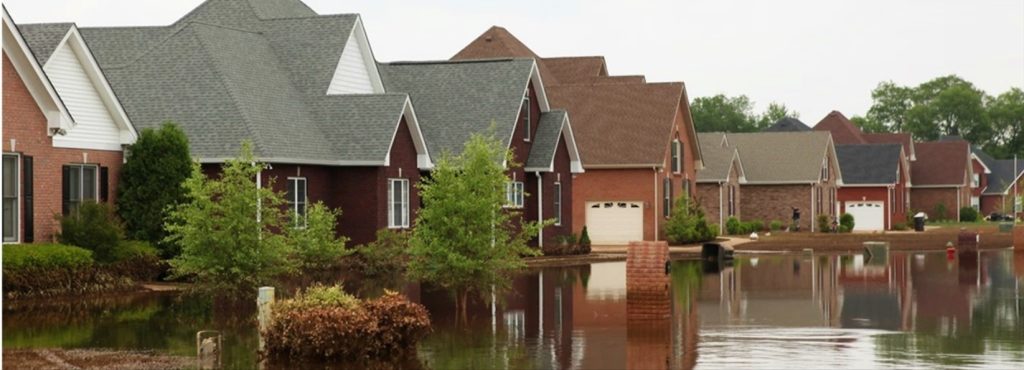
How many of us ask about flood risk before buying a house or renting an apartment?
In many areas of the country, whether we rent or buy, no one mentions flood risk. And yet, for millions of homes, flood risks keep increasing.
Knowing whether a home has flooded, or is at high risk of flooding, helps us grasp the financial risks involved with a home. “Just one inch of flooding can cause $25,000 in structural damage,” says the National Association of REALTORS®.
In light of the issue’s importance, four states are implementing new disclosure policies.
New York, New Jersey, and the Carolinas: All Are Making Disclosure Mandatory
A little water can turn into an expensive problem all too quickly. When water seeps into vanities, cabinets and other furnishings, and into the floors or walls, it has to be addressed. Otherwise, potentially toxic conditions could follow.
And now, New York and New Jersey have passed laws to require disclosure of risks to buyers. Additionally, the North Carolina and South Carolina real estate commissions are in the process of issuing new disclosure forms.
Do you live in one of these states, or hope to? Then this information is for you. If you’re moving into a home in one of these states, you’re entitled to disclosure if the home, condo, or rental apartment has flooded in the past — and the likelihood of future flooding.
In all four states, potential home buyers will:
- Get a disclosure form with flood information once they’ve made an offer on a home.
- Have the option to cancel a purchase offer based on the disclosed information.
The new rules look a lot like the ones already existing in frequently flooded U.S. areas, such as the southern Gulf states.
What other state laws might be coming? Watch Vermont, which suffered catastrophic flooding in 2023. Several proposed laws have also arisen in Florida.
Do Renters Face Special Risks?
While owners have their property values to watch, renters have their own set of concerns. Many renters pay for housing month to month, without ample cash reserves set aside for emergencies. And many are vulnerable to being displaced by their landlords after water inundation.
So it’s helpful that New York and New Jersey have given some thought to disclosure for renters. Through the new laws, in both New Jersey and New York, landlords must inform renters about their flood risk.
A few other states have also taken care to extend legal protection to renters. Here’s a hat tip to the lawmakers of California, Georgia, Indiana, Oklahoma, Oregon, and Texas. These states have hashed out requirements for landlords to inform people about flood risk — before they forge lease agreements.
Doesn’t the Federal Government Cover Flood Risks?

Yes and no.
Government agencies and companies use maps showing the Federal Emergency Management Agency’s Special Flood Hazard Areas to determine insurance needs. FEMA’s information enables insurers to set the premium prices. And government-backed mortgages have coverage with the National Flood Insurance Program where homes are at risk.
But the National Flood Insurance Program applies specifically to designated flood zone areas. Banks won’t finance those properties without it.
Funding for the program is currently facing its own risks. In September 2023, U.S. Congress members managed to renew funding for the National Flood Insurance Program — well, until Nov. 17, 2023. Existing policies under the program are good until they expire (plus the 30-day grace period). As long as FEMA still has funds, it can cover claims. If you have the government’s flood protection insurance, it’s a good idea to check and see if it’s time to renew your policy.
If you’re like many homeowners, you don’t have the national insurance. Why not? Because your home is outside FEMA’s designated zones. But a home that’s not in a FEMA zone can still flood. No home is off-limits to the water’s reach. Just about anywhere you live across the United States, you’re going to experience flooding if you live there long enough.
The National Association of REALTORS® points to a downloadable file with Private Flood Insurance Resources for those who are not within FEMA’s coverage areas. Be sure to read any policy carefully before making a purchase.
New Tool We Can All Use: Risk Factor
Now, we can all get useful information directly, thanks to the First Street Foundation Flood Model. Here’s how to do it online, in seconds. Look up your address on Risk FactorTM to get instant data on your flood risk. (Deeds.com is not affiliated with Risk Factor.)
The Risk Factor site is a new and useful initiative. Its Flood Factor® tool has expanded mapping power. It reveals about three times as much risk as FEMA’s tools do. While FEMA determines flood risks for areas by measuring overflowing waterways and storm surges, the newer Flood Factor® tool anticipates flood risks from:
- Heavy rains.
- The growing hazards of climate change, including stronger hurricanes and heavier storms.
- The way flood risks change and add up over time.
- Urban and suburban stormwater runoff as well as storm surge.
- Tidal river dynamics.
- Future conditions including sea level rise.
The methods and data forming the First Street Foundation Flood Model come from respected resources. It uses many sources of local data. Its Risk Factor tool also draws from FEMA, from the National Oceanic and Atmospheric Administration (NOAA), and the United States Geological Survey (USGS), as well as international research databases. In this way, the new tool can be used to supplement existing tools.
Flood Factor calculates flood risk in detail, down to the individual property level. Because it accounts for so much interrelated data, Flood Factor offers more than the either-or (floodplain or not) FEMA mapping.
States Will Need to Step Up. Meanwhile…We Educate Ourselves.
FEMA traditionally covers damage related to living on a waterfront or flood plain. Whether it makes any sense to subsidize construction in flood-prone areas with federal tax money is a question for another day. For now, we need to know our own risks — and our disclosure responsibilities.
Risk Factor exposes issues that affect millions of properties over the course of their mortgages. And flooding is the single most expensive risk for homes. People who face these risks are pressing lawmakers to update flood disclosure rules. We intend to keep you posted.
Meanwhile, at least we have a tool to learn about the risks at specific properties we own, rent, or might want to buy.
Supporting References
Rebecca Hersher on All Things Considered, National Public Radio via NPR.org: Climate – Residents of Four States Will Get More Information About Flood Risk to Their Homes (Sep. 8, 2023).
Risk Factor™ / Flood Factor® Why a Property’s FEMA Zone Does Not Impact its Flood Factor.
National Association of REALTORS® REALTOR® Magazine: Flood Insurance FAQ: National Flood Insurance Program Expires November 17, 2023 (Oct. 1, 2023).
National Association of REALTORS®: Breaking News: NFIP Extended in Last-Minute Funding Deal (Sep. 30, 2023).
And as linked.
More on topics: Stormwater fees, Zoning and climate
Photo credits: FEMA/David Fine via (public domain) derived from the U.S. National Archives via Picryl; and Markus Spiske, via Pexels.
